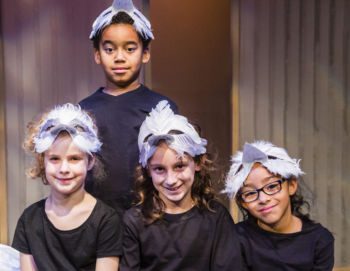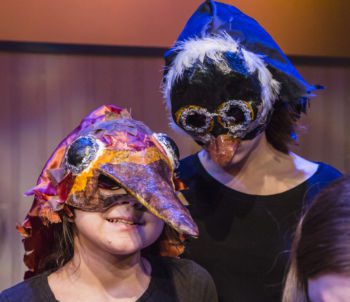May 17, 2022 Community Stories
Where Sparking Imaginations Opens Doors for Young People
The former All Saints Church in Springfield may seem an unlikely place for young people to study playwriting, acting or choreography. “The church campus is actually three buildings with secret Victorian passageways,” according to Amelia Hays-Rivest.
But, for more than 30 years, the reconditioned former church is exactly where The Drama Studio has run a conservatory-style theater training program. There, children and youth indulge in a 63-seat black box theater, large teaching spaces, music theater rooms, and a Shakespeare library.

Hays-Rivest, the Studio’s director, calls it “a unique space right smack in the middle of Springfield.” And it’s where young people from different backgrounds form lifelong friendships.
The key to success? Program Manager Stephanie Reyes Echavarria points to the process of training students as an ensemble. Young people learn to feel supported, trusted, and listened to by the group.
“Our alumni say this was the one space where they had a chance to become very close with people they would never encounter otherwise,” Hays-Rivest said.
Now, the Studio — with a flexible funding grant from the Community Foundation — is reaching beyond its walls to engage young people in Springfield Public Schools. It’s building upon its successful DramaTours program in the schools to address current challenges: mental health and literacy.
Rates of anxiety and depression among youth have soared during the pandemic, reported Hays-Rivest. She believes access to the arts gives students a vehicle for their emotions. And, importantly, the Studio’s partnership with schools opens “a front door to literacy.”

That’s why the Studio launched its TheaterReaders program, which teams Hays-Rivest with Springfield schoolteachers. Together, they use the Studio’s techniques to teach language arts and science. Elementary school students who participated in the pilot program scored significantly higher on unit exams than their peers.
If you saw Hays-Rivest hauling boxes from the Studio into the schools, she was creating “magical places” for TheaterReaders classes.
For poetry lessons about clouds, she turned an entire classroom into a sky. Students had 40-foot blue silks, white head pieces, rain sticks and thunder sheets (“all this experiential stuff,” she said).

And for a lesson on rivers, she transformed a classroom into river rapids. Students improvised with paddles, platform dollies, and massive blue silks, interpreting the perspectives of rocks, river riders, and unexpected visitors like news reporters.
“Kids were spinning on the floor as if we were churning in a river,” said Hays-Rivest. “They had no idea what ‘churning’ was — especially those who use English as a second language. We talked about what a fun word it was. Later, they became more successful on science tests because, as we improvised, we laced in every single new vocabulary word.”
“Kids make unexpected connections,” she added. “And that’s a beautiful thing.”
